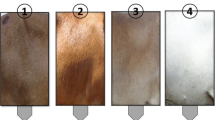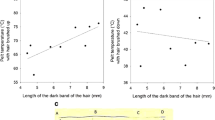Abstract
Not all of the solar radiation that impinges on a mammalian coat is absorbed and converted into thermal energy at the coat surface. Some is reflected back to the environment, while another portion is reflected further into the coat where it is absorbed and manifested as heat at differing levels. Substantial insulation in a coat limits the thermal impact at the skin of solar radiation, irrespective where in the coat it is absorbed. In coats with low insulation, the zone where solar radiation is absorbed may govern the consequent heat load on the skin (HL-SR). Thin summer furs of four species of kangaroo from differing climatic zones were used to determine how variation in insulation and in coat spectral and structural characteristics influence the HL-SR. Coat depth, structure, and solar reflectance varied between body regions, as well as between species. The modulation of solar radiation and resultant heat flows in these coats were measured at low (1 m s−1) and high (6 m s−1) wind speeds by mounting them on a heat flux transducer/temperature-controlled plate apparatus in a wind tunnel. A lamp with a spectrum similar to solar radiation was used as a proxy for the sun. We established that coat insulation was largely determined by coat depth at natural fur lie, despite large variations in fibre density, fibre diameter, and fur mass. Higher wind speed decreased coat insulation, but depth still determined the overall level. A multiple regression analysis that included coat depth (insulation), fibre diameter, fibre density, and solar reflectance was used to determine the best predictors of HL-SR. Only depth and reflectance had significant impacts and both factors had negative weights, so, as either insulation or reflectance increased, HL-SR declined, the larger impact coming from coat reflectance. This reverses the pattern observed in deep coats where insulation dominates over effects of reflectance. Across all coats, as insulation declined, reflectance increased. An increase in reflectance in the thinnest coats was not the sole reason for the limited rise in HL-SR. Higher reflectance should increase the depth of penetrance of solar radiation, thus increasing HL-SR. But in M. antilopinus and Macropus rufus, which had the highest of coat reflectances, penetrance was relatively shallow. This effect appears due to high fibre density (M. rufus) and major modifications in the fibre structure (M. antilopinus). The differing adaptations likely relate to the habitats of these species, desert in the case of M. rufus and monsoon tropical woodland with M. antilopinus.






Similar content being viewed by others
References
Dawson TJ (1973) Thermoregulatory responses of the arid zone kangaroos, Megaleia rufa and Macropus robustus. Comp Biochem Physiol 46A:153–169
Dawson TJ (2012) Kangaroos. CSIRO Publishing, Collingwood
Dawson TJ, Brown GD (1970) A comparison of the insulative and reflective properties of the fur of desert kangaroos. Comp Biochem Physiol 37:23–38
Dawson TJ, Denny MJS (1969) A bioclimatological comparison of the summer day microenvironments of two species of arid zone kangaroo. Ecology 50:329–332
Dawson TJ, Maloney SK (2004) Fur versus feathers: the different roles of red kangaroo fur and emu feathers in thermoregulation in the Australian arid zone. Aust Mammal 26:145–151
Dawson T, Maloney S (2008) the significance of fur characteristics in the thermal challenges posed by solar radiation: an underestimated role and source of adaptability? In: Morris S, Vosloo A (eds) Molecules to migration: the pressures of life. Proceedings of the 4th CPB Meeting in Africa: Mara 2008. Medimond International Proceedings, Bologna, pp 361–374
Dawson T, Schmidt-Nielsen K (1966) Effect of thermal conductance on water economy in the Antelope Jack Rabbit, Lepus alleni. Cell Physiol 67:463–471
Dawson TJ, Robertshaw D, Taylor CR (1974) Sweating in the kangaroo: a cooling mechanism during exercise, but not in the heat. Am J Physiol 227:494–498
Dawson TJ, Blaney CE, Munn AJ, Krockenberger A, Maloney SK (2000a) Thermoregulation by kangaroos from mesic and arid habitats: influence of temperature on routes of heat loss in grey kangaroos (Macropus giganteus) and red kangaroos (Macropus rufus). Physiol Biochem Zool 73:374–381
Dawson TJ, Munn AJ, Blaney CE, Krockenberger A, Maloney SK (2000b) Ventilatory accommodation of oxygen demand and respiratory water loss in kangaroos from mesic and arid environments, the eastern Grey Kangaroo (Macropus giganteus) and the red kangaroo (M. rufus), and a re-examination of ventilatory allometry for marsupials. Physiol Biochem Zool 73:382–388
Dawson TJ, Blaney CE, McCarron HCK, Maloney SK (2007) Dehydration, with and without heat, in kangaroos (Macropus giganteus and Macropus rufus) from mesic and arid habitats: different thermal responses including varying patterns in heterothermy in the field and laboratory. J Comp Physiol B 177:797–807
Dawson TJ, Webster KN, Maloney SK (2014) The fur of mammals in exposed environments; do crypsis and thermal needs necessarily conflict? The polar bear and marsupial koala compared. J Comp Physiol B 184:273–284
Dimpel H (1971) Tanning large skins for museum collections. C.S.I.R.O, Melbourne
Gebremedhin KG, Ni H, Hillman PE (1997) Modeling temperature profile and heat flux through irradiated fur layer. Trans Am Soc Agric Eng 40(5):1441
Hammel HT (1955) Thermal properties of fur. Amer J Physiol 182:369–376
Hetem RS, de Witt BA, Fick LG, Fuller A, Kerley GIH, Meyer LCR, Mitchell D, Maloney SK (2009) Body temperature, thermoregulatory behaviour and pelt characteristics of three colour morphs of springbok (Antidorcas marsupialis). Comp Biochem Physiol A 152:379–388
Hutchinson JCD, Brown GD (1969) Penetrance of cattle coats by radiation. J Appl Physiol 26:454–464
Kovarik M (1964) Flow of heat in an irradiated protective cover. Nature 201:1085–1087
Maloney SK, Dawson TJ (1995) The heat load from solar radiation on a large, diurnally active bird, the emu (Dromaius novaehollandiae). J Therm Biol 20:381–387
Maloney SK, Fuller A, Meyer LCR, Kamerman PR, Mitchell G, Mitchell D (2011) Minimum daily core body temperature in western grey kangaroos decreases as summer advances: a seasonal pattern, or a direct response to water, heat or energy supply? J Exper Biol 214:1813–1820
McCullough DR, McCullough Y (2000) Kangaroos in outback Australia. Comparative ecology and behaviour of three coexisting species. Columbia University Press, New York
Moore KE, Blache D, Maloney SK (2011) Fibre diameter and insulation in alpacas: the biophysical implications. Small Rumin Res 96:165–172
Schmidt-Nielsen K, Dawson TJ, Hammel HT, Hinds D, Jackson DC (1965) The Jack Rabbit—a study in its desert survival. Hvalradets Skrifter Nr 48:125–142
Scholander PF, Hock R, Walters V, Irving L (1950a) Adaptation to cold in Arctic and tropical mammals and birds in relation to body temperature, insulation and basal metabolic rate. Biol Bull 99:259–271
Scholander PF, Hock R, Walters V, Johnson F, Irving L (1950b) Heat regulation in some Arctic and tropical mammals and birds. Biol Bull 99:237–258
Scholander PF, Walters V, Hock R, Irving L (1950c) Body insulation of some Arctic and tropical mammals. Biol Bull 99:225–236
Walsberg GE (1983) Coat color and solar heat gain in animals. Bioscience 33:88–91
Walsberg GE (1988) The significance of fur structure for solar heat gain in the rock squirrel, Spermophilus variegatus. J Exp Biol 138:243–257
Walsberg GE (1990) Convergence of solar heat gain in two squirrel species with contrasting coat colors. Physiol Zool 63:1025–1042
Walsberg GE, Schmidt CA (1989) Seasonal adjustment of solar heat gain in a desert mammal by altering coat properties independent of surface coloration. J Exp Biol 142:387–400
Acknowledgements
We thank Dr. JF Hallam and Dr. KN Webster for assistance with coat measurements. Prof. Steven Dain of the School of Optometry, University of New South Wales, Sydney, NSW is thanked for providing access to the Optronics model 746-IRD Spectroradiometer. Dr. Thomas J Bruno from the Applied Chemicals and Materials Division of the National Institute of Standards and Technology, USA, provided the certified thermal blanket that was used to calibrate the heat flux transducers. This research was funded in part by a Grant from the Australian Research Council to TJD. Animals were taken under a licence (A18) from the NSW National Parks and Wildlife Service, except for Macropus antilopinus, which were taken with the permission of the Director, Animal Industry Branch, Northern Territory Administration. The study was carried out under approvals given by the University of NSW Animal Care and Ethics Committee.
Author information
Authors and Affiliations
Corresponding author
Additional information
Communicated by I. D. Hume.
Rights and permissions
About this article
Cite this article
Dawson, T.J., Maloney, S.K. Thermal implications of interactions between insulation, solar reflectance, and fur structure in the summer coats of diverse species of kangaroo. J Comp Physiol B 187, 517–528 (2017). https://doi.org/10.1007/s00360-016-1043-8
Received:
Revised:
Accepted:
Published:
Issue Date:
DOI: https://doi.org/10.1007/s00360-016-1043-8




